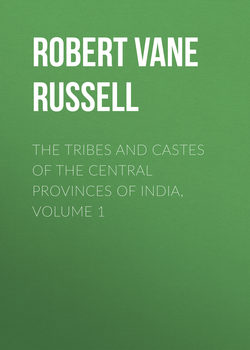Читать книгу The Tribes and Castes of the Central Provinces of India, Volume 1 - Robert Vane Russell - Страница 45
Part I.
Introductory Essay on Caste
Introductory Essay on Caste
42. Occupation the basis of the caste system
ОглавлениеIt has been seen that the old Aryan polity comprised four classes: the Brāhmans and Kshatriyas or priestly and military aristocracy; the Vaishyas or body of the Aryans, who were ceremonially pure and could join in sacrifices; and the Sūdras or servile and impure class of labourers. The Vaishyas became cultivators and herdsmen, and their status of ceremonial purity was gradually transferred to the cultivating members of the village community, because land was the main source of wealth. Between the last two there arose another class of village menials and craftsmen, originating principally from the offspring of fathers of the Aryan classes and Sūdra women, to whom was left the practice of the village industries, despised by the cultivators. In spite of the almost complete fusion of races which the intercourse of centuries has effected, and the multiplication and rearrangement of castes produced by the diversity of occupation and other social factors, the divisions of the village community can still be recognised in the existing social gradation.
It has been seen also that occupation is the real basis of the division and social precedence of castes in India, as in all communities which have made any substantial progress in civilisation and social development. Distinctions of race, religion and family gradually disappear, and are merged in the gradation according to wealth or profession. The enormous majority of castes are occupational and their social position depends on their caste calling. Thus in the case of an important industry like weaving, there are separate castes who weave the finer kinds of cloth, as the Tāntis and Koshtis, while one subcaste of Koshtis, the Sālewārs, are distinguished as silk-weavers, and a separate caste of Patwas embroider silk and braid on cloth; other castes, as the Mahārs, Gāndas and Koris, weave coarse cloth, and a distinct caste of Katias existed for the spinning of thread, and the Muhammadan caste of Bahnas for cleaning cotton. The workers in each kind of metal have formed a separate caste, as the Lohārs or blacksmiths, the Kasārs or brass-workers, the Tameras or coppersmiths, and the Sunārs or gold- and silversmiths, while the Audhia subcaste of Sunārs83 and the Bharewas, an inferior branch of the Kasārs, work in bell-metal. Each of these castes makes ornaments of its own metal, while the Kachera caste84 make glass bangles, and the Lakheras make bangles from lac and clay. In the case of agriculture, as has been seen, there is usually a functional cultivating caste for each main tract of country, as the Jāts in the Punjab, the Kurmis in Hindustān, the Kunbis in the Deccan, the Chasas in Orissa, the Kāpus in the Telugu country and the Vellālas in the Tamil country. Except the Jāts, who were perhaps originally a racial caste, the above castes appear to include a number of heterogeneous groups which have been welded into a single body through the acquisition of land and the status which it confers. Various other cultivating castes also exist, whose origin can be traced to different sources; on obtaining possession of the land they have acquired the cultivating status, but retained their separate caste organisation and name. Other agricultural castes have been formed for the growing of special products. Thus the Mālis are gardeners, and within the caste there exist such separate groups as the Phūlmālis who grow flowers, the Jire Mālis cumin and the Halde Mālis turmeric.85 Hindus generally object to cultivate sān-hemp,86 and some special castes have been formed from those who grew it and thus underwent some loss of status; such are the Lorhas and Kumrawats and Pathinas, and the Santora subcaste of Kurmis. The āl87 or Indian madder-dye is another plant to which objection is felt, and the Alia subcastes of Kāchhis and Banias consist of those who grow and sell it. The Dāngris and Kāchhis are growers of melons and other vegetables on the sandy stretches in the beds of rivers and the alluvial land on their borders which is submerged in the monsoon floods. The Barais are the growers and sellers of the betel-vine.
Several castes have been formed from military service, as the Marāthas, Khandaits, Rautias, Taonlas and Pāiks. All of these, except the Marāthas, are mainly derived from the non-Aryan tribes; since they have abandoned military service and taken as a rule to agriculture, their rank depends roughly on their position as regards the land. Thus the Marāthas and Khandaits became landowners, receiving grants of property as a reward for, or on condition of, military service like the old feudal tenures; they rank with, but somewhat above, the cultivating castes. The same is the case, though to a less degree, with the Rautias of Chota Nāgpur, a military caste mainly formed from the Kol tribe. On the other hand, the Pāiks or foot-soldiers and Taonlas have not become landholders and rank below the cultivating castes. The Hatkars are a caste formed from Dhangars or shepherds who entered the Marātha armies. They are now called Bangi Dhangars or shepherds with the spears, and rank a little above other Dhangars.
83
Loha, iron; tamba, copper; kānsa, brass or bell-metal; sona, gold.
84
Kānch, glass.
85
Phul, flower; haldi,turmeric; jira, cumin.
86
Crotalaria juncea. See article Lorha for a discussion of the objections to this plant.
87
Morinda citrifolia. The taboo against the plant is either because the red dye resembles blood, or because a number of insects are destroyed in boiling the roots to extract the dye.
